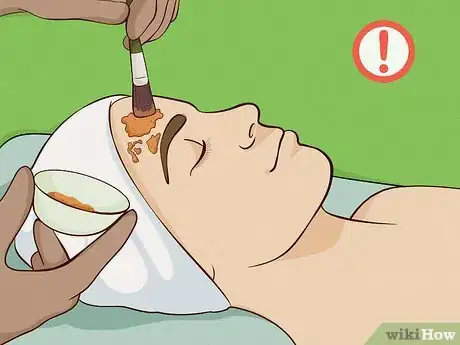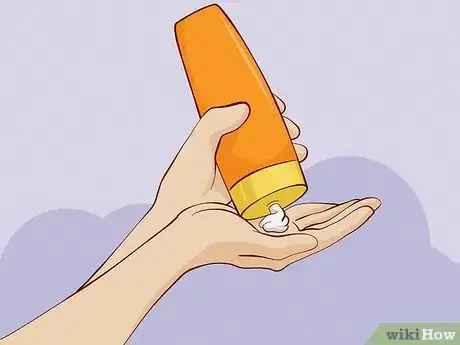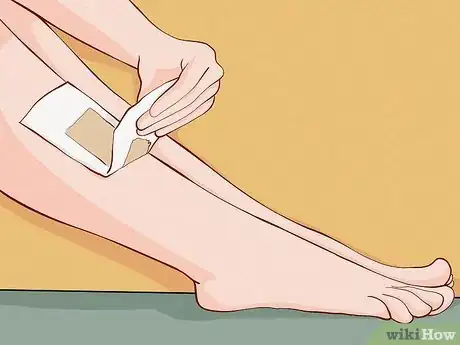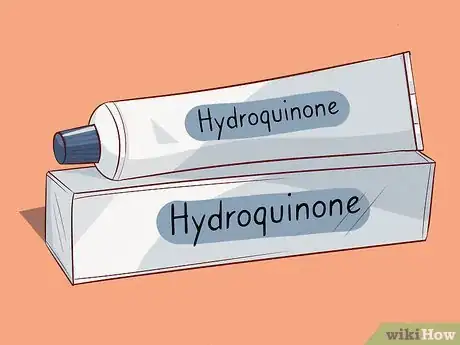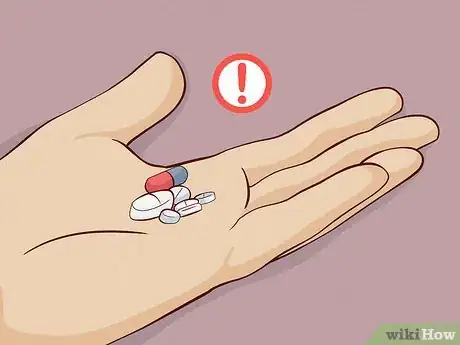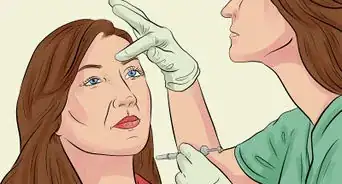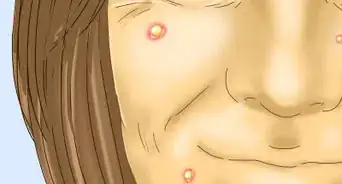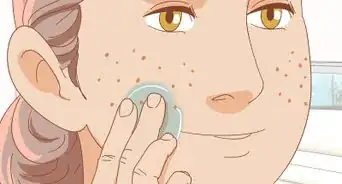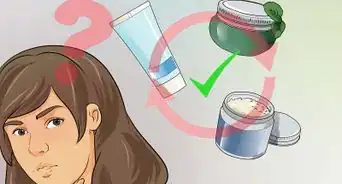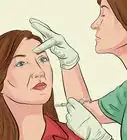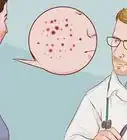This article was co-authored by Aanand Geria, MD. Dr. Aanand Geria is a board certified dermatologist, a clinical instructor at Mt. Sinai, and the owner of Geria Dermatology based in Rutherford, New Jersey. Dr. Geria's work has been featured in Allure, The Zoe Report, NewBeauty, and Fashionista, and he has peer-reviewed work for the Journal of Drugs in Dermatology, Cutis, and Seminars in Cutaneous Medicine and Surgery. He holds a BS from the Penn State University and an MD from Rutgers New Jersey Medical School. Dr. Geria then finished an internship at Lehigh Valley Health Network and a dermatology residency at the Howard University College of Medicine.
There are 11 references cited in this article, which can be found at the bottom of the page.
This article has been viewed 101,568 times.
A chemical peel is an effective way to rejuvenate the skin, remove minor imperfections like wrinkles and scars, and achieve a younger-looking complexion. Chemical peels essentially strip away the outer layers of skin to allow smoother, younger-looking skin to grow in its place.[1] The procedure typically targets one of three skin depths: a light peel removes the epidermis, a medium peel removes skin down to the dermis, and a deep peel works down to the lower layers of dermis.[2] Many peels do not require any significant preparation, but some require a skin care regimen leading up to the day of the peel. Knowing how to prepare for your chemical peel can help you ensure a successful treatment session.
Steps
Avoiding Skin Stress Before Treatment
-
1Refrain from any other chemical peels. In the two weeks leading up to a chemical peel, it is imperative that you refrain from having any other chemical peel treatments. If it has been less than two weeks since your last chemical peel, you should wait until at least 14 days have passed.
-
2Avoid microdermabrasion treatments. Microdermabrasion treatments work similar to chemical peels, except this treatment uses a gentle abrasive tool to peel off the outer layer of skin.[3] If you are planning on having a chemical peel performed, you should avoid having a microdermabrasion treatment for at least 14 days before the procedure.Advertisement
-
3Cut out tanning booths. Tanning, including the use of artificial UV radiation in tanning booths, can cause significant damage to the skin.[4] For this reason, it is imperative that anyone planning on having a chemical peel avoid tanning for at least two to three weeks before the treatment.
-
4Limit sun exposure. While you should not engage in tanning for two to three weeks before a chemical peel, you should also limit all sun exposure for at least ten days before the treatment.
- If you must be in the sun for any duration of time in the two to three weeks before a treatment, you should wear sunscreen and try to limit your time outdoors as much as possible.[5]
- To lessen your exposure to the sun, it can be helpful to schedule your chemical peel for the fall or winter, when the sun's rays aren't as strong.[6]
-
5Be gentle on your skin. As you prepare for a chemical peel, you will need to refrain from waxing your skin or using chemical depilatory (hair removal) treatments for at least five to seven days before treatment. You should also avoid all chemical injection treatments, including Botox and collagen injections, for at least one week before the treatment.
Preparing Your Skin
-
1Take antiviral medication as needed. Some people preparing for a chemical peel will not need to take antiviral medication. However, if you have a history of herpes infections on or around your mouth, your doctor may prescribe an antiviral medication for you to take before and after the treatment.[7]
- Acyclovir (Zovirax) is a common antiviral medication used to prevent cold sore/herpes outbreaks prior to a chemical peel. Acyclovir is typically taken for between two days and one week before the treatment and up to two weeks after the treatment.[8] This medication is commonly dosed at 200 mg five times each day.[9]
- Valacyclovir is another common antiviral medication. It is typically dosed at one gram three times daily. Valacyclovir should be taken for at least two days before the treatment and for 10 to 14 days after the treatment.[10]
-
2Apply prescribed lotions. Depending on the depth of chemical peel you will be undergoing, your doctor may recommend that you use a moisturizing and healing lotion on your skin before the treatment.
- Glycolic acid lotion is typically recommended for light chemical peels. This lotion is used for two weeks before the treatment to help ensure that your skin peels uniformly and heals more easily.[11]
- A retinoid cream like tretinoin or Retin-A is used for light or medium chemical peels to help shorten the duration of your treatment and speed up the healing process.[12] Retinoid use is typically discontinued three days before the treatment.[13]
-
3Use a bleaching agent. Depending on your skin complexion, your doctor may recommend the use of a bleaching agent like hydroquinone, especially in conjunction with a retinoid cream like tretinoin. Using a bleaching agent before treatment can help prevent your skin from darkening during the treatment.[14]
-
4Learn about medication interactions. Depending on what medications your are currently taking, your doctor may recommend that you discontinue some of those medications before undergoing your chemical peel.[17] The most common medications that must be discontinued before treatment are photosensitizing drugs, which increase your sensitivity to sunlight and may cause inflammation after exposure to sunlight.[18] Common photosensitizing drugs include:
- antihistamines[19]
- coal tar and coal tar derivatives[20]
- certain contraceptives (birth control pills and female sex hormones)[21]
- non-steroidal anti-inflammatory drugs[22]
- phenothiazines (tranquilizers)[23]
- psoralens[24]
- sulfonamides (antimicrobials)[25]
- sulfonylureas (oral diabetes medications)[26]
- thiazide diuretics (water pills)[27]
- tetracyclines (antibiotics)[28]
- tricyclic antidepressants[29]
Going In for the Procedure
-
1Avoid smoking. If you are a smoker, you will most likely need to discontinue smoking well in advance of your procedure.[30] Talk to your doctor about when to quit and how to follow through on your plan to quit smoking.
-
2Take antibiotics. If your doctor has recommended that you take antibiotics before having a chemical peel, you should begin taking those at least 24 hours before the procedure. If you are required to take antiviral medication, you should also be taking that medication for at least 24 hours before your treatment.[31]
-
3Learn if you have medical allergies. Some patients undergoing a deep-tissue chemical peel will be required to undergo sedation before the procedure. If you have any known allergies to sedatives or pain medications, you should let your doctor know right away to avoid any potential drug allergies.[32]
-
4Arrange for a ride home. If you are undergoing a deep-tissue chemical peel, you may be required to undergo sedation in order to effectively penetrate to deeper skin depths. If you know you will be undergoing sedation during your procedure, arrange for a ride home ahead of time, as you will not be able to drive home after sedation.[33]
Expert Q&A
-
QuestionWhy does my skin look worse after a chemical peel?
 Aanand Geria, MDDr. Aanand Geria is a board certified dermatologist, a clinical instructor at Mt. Sinai, and the owner of Geria Dermatology based in Rutherford, New Jersey. Dr. Geria's work has been featured in Allure, The Zoe Report, NewBeauty, and Fashionista, and he has peer-reviewed work for the Journal of Drugs in Dermatology, Cutis, and Seminars in Cutaneous Medicine and Surgery. He holds a BS from the Penn State University and an MD from Rutgers New Jersey Medical School. Dr. Geria then finished an internship at Lehigh Valley Health Network and a dermatology residency at the Howard University College of Medicine.
Aanand Geria, MDDr. Aanand Geria is a board certified dermatologist, a clinical instructor at Mt. Sinai, and the owner of Geria Dermatology based in Rutherford, New Jersey. Dr. Geria's work has been featured in Allure, The Zoe Report, NewBeauty, and Fashionista, and he has peer-reviewed work for the Journal of Drugs in Dermatology, Cutis, and Seminars in Cutaneous Medicine and Surgery. He holds a BS from the Penn State University and an MD from Rutgers New Jersey Medical School. Dr. Geria then finished an internship at Lehigh Valley Health Network and a dermatology residency at the Howard University College of Medicine.
Board Certified Dermatologist You may notice your skin peeling for a couple of days after the procedure. This is normal, and isn't anything to worry about.
You may notice your skin peeling for a couple of days after the procedure. This is normal, and isn't anything to worry about. -
QuestionWhat should I avoid before getting a chemical peel?
 Aanand Geria, MDDr. Aanand Geria is a board certified dermatologist, a clinical instructor at Mt. Sinai, and the owner of Geria Dermatology based in Rutherford, New Jersey. Dr. Geria's work has been featured in Allure, The Zoe Report, NewBeauty, and Fashionista, and he has peer-reviewed work for the Journal of Drugs in Dermatology, Cutis, and Seminars in Cutaneous Medicine and Surgery. He holds a BS from the Penn State University and an MD from Rutgers New Jersey Medical School. Dr. Geria then finished an internship at Lehigh Valley Health Network and a dermatology residency at the Howard University College of Medicine.
Aanand Geria, MDDr. Aanand Geria is a board certified dermatologist, a clinical instructor at Mt. Sinai, and the owner of Geria Dermatology based in Rutherford, New Jersey. Dr. Geria's work has been featured in Allure, The Zoe Report, NewBeauty, and Fashionista, and he has peer-reviewed work for the Journal of Drugs in Dermatology, Cutis, and Seminars in Cutaneous Medicine and Surgery. He holds a BS from the Penn State University and an MD from Rutgers New Jersey Medical School. Dr. Geria then finished an internship at Lehigh Valley Health Network and a dermatology residency at the Howard University College of Medicine.
Board Certified Dermatologist Avoid using products with ingredients like glycolic acid or retinol for about 5-7 days before you get a chemical peel. These can irritate your skin, which could lead to burns or hyperpigmentation.
Avoid using products with ingredients like glycolic acid or retinol for about 5-7 days before you get a chemical peel. These can irritate your skin, which could lead to burns or hyperpigmentation.
Warnings
- Keep in mind that a chemical peel should be done by a certified person, preferably a dermatologist, plastic surgeon, or other medical doctor with specific training in the procedure, especially if the peel you are having done is medium or deep. There are risks to the procedure and only an experienced and qualified person can properly advise if a chemical peel is a good choice for you and they should know your medical history before the procedure as well.⧼thumbs_response⧽
References
- ↑ http://www.mayoclinic.org/tests-procedures/chemical-peel/basics/definition/prc-20023436
- ↑ http://www.mayoclinic.org/tests-procedures/chemical-peel/basics/why-its-done/prc-20023436
- ↑ http://www.plasticsurgery.org/cosmetic-procedures/microdermabrasion.html
- ↑ http://hps.org/publicinformation/ate/faqs/tanningbooths.html
- ↑ http://www.ncbi.nlm.nih.gov/pmc/articles/PMC3047741/
- ↑ Aanand Geria, MD. Board Certified Dermatologist. Expert Interview. 8 July 2020.
- ↑ http://www.mayoclinic.org/tests-procedures/chemical-peel/basics/how-you-prepare/prc-20023436
- ↑ http://www.medicinenet.com/chemical_peel/page3.htm#how_does_one_prepare_for_a_chemical_peel
- ↑ http://www.ncbi.nlm.nih.gov/pmc/articles/PMC3047741/
- ↑ http://www.ncbi.nlm.nih.gov/pmc/articles/PMC3047741/
- ↑ http://www.mayoclinic.org/tests-procedures/chemical-peel/basics/how-you-prepare/prc-20023436
- ↑ http://www.mayoclinic.org/tests-procedures/chemical-peel/basics/how-you-prepare/prc-20023436
- ↑ http://www.ncbi.nlm.nih.gov/pmc/articles/PMC3047741/
- ↑ http://www.mayoclinic.org/tests-procedures/chemical-peel/basics/how-you-prepare/prc-20023436
- ↑ http://www.medicinenet.com/chemical_peel/page3.htm#how_does_one_prepare_for_a_chemical_peel
- ↑ http://www.ncbi.nlm.nih.gov/pmc/articles/PMC3047741/
- ↑ https://my.clevelandclinic.org/health/treatments_and_procedures/hic_Chemical_Peels
- ↑ http://www.ncbi.nlm.nih.gov/pmc/articles/PMC3047741/
- ↑ http://www.fda.gov/downloads/Radiation-EmittingProducts/RadiationEmittingProductsandProcedures/SurgicalandTherapeutic/UCM135813.pdf
- ↑ http://www.fda.gov/downloads/Radiation-EmittingProducts/RadiationEmittingProductsandProcedures/SurgicalandTherapeutic/UCM135813.pdf
- ↑ http://www.fda.gov/downloads/Radiation-EmittingProducts/RadiationEmittingProductsandProcedures/SurgicalandTherapeutic/UCM135813.pdf
- ↑ http://www.fda.gov/downloads/Radiation-EmittingProducts/RadiationEmittingProductsandProcedures/SurgicalandTherapeutic/UCM135813.pdf
- ↑ http://www.fda.gov/downloads/Radiation-EmittingProducts/RadiationEmittingProductsandProcedures/SurgicalandTherapeutic/UCM135813.pdf
- ↑ http://www.fda.gov/downloads/Radiation-EmittingProducts/RadiationEmittingProductsandProcedures/SurgicalandTherapeutic/UCM135813.pdf
- ↑ http://www.fda.gov/downloads/Radiation-EmittingProducts/RadiationEmittingProductsandProcedures/SurgicalandTherapeutic/UCM135813.pdf
- ↑ http://www.fda.gov/downloads/Radiation-EmittingProducts/RadiationEmittingProductsandProcedures/SurgicalandTherapeutic/UCM135813.pdf
- ↑ http://www.fda.gov/downloads/Radiation-EmittingProducts/RadiationEmittingProductsandProcedures/SurgicalandTherapeutic/UCM135813.pdf
- ↑ http://www.fda.gov/downloads/Radiation-EmittingProducts/RadiationEmittingProductsandProcedures/SurgicalandTherapeutic/UCM135813.pdf
- ↑ http://www.fda.gov/downloads/Radiation-EmittingProducts/RadiationEmittingProductsandProcedures/SurgicalandTherapeutic/UCM135813.pdf
- ↑ http://my.clevelandclinic.org/cosmetic-plastic-surgery/procedures/facial-resurfacing/chemical-peels
- ↑ https://my.clevelandclinic.org/health/treatments_and_procedures/hic_Chemical_Peels
- ↑ http://my.clevelandclinic.org/cosmetic-plastic-surgery/procedures/facial-resurfacing/chemical-peels
- ↑ http://www.mayoclinic.org/tests-procedures/chemical-peel/basics/how-you-prepare/prc-20023436
About This Article
A chemical peel is a great way to rejuvenate your skin and remove minor imperfections like wrinkles and scars. Before you get a chemical peel, refrain from tanning, microdermabrasion, and other chemical peels for at least two weeks so your skin isn't damaged. You’ll also need to stop waxing or using hair removal products at least 5 days before the chemical peel. Talk to your doctor before your chemical peel to see if there’s anything you should do to prepare. They may recommend you use lotion beforehand to keep your skin moisturized. On the day of the peel, arrange for a ride home, since you may be sedated and unable to drive afterward. To learn more from our Medical co-author, like if you’ll need to take antibiotics before your peel, read on!
